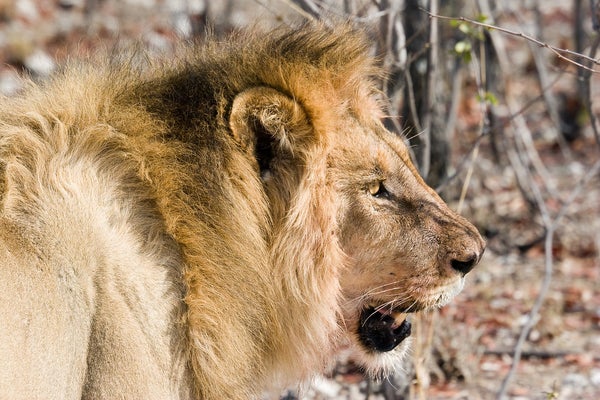This article was published in Scientific American’s former blog network and reflects the views of the author, not necessarily those of Scientific American
It’s been a year since the illegal killing of Cecil the lion sparked a worldwide outcry against lion trophy hunting, but a new report reminds us that the problems lions face are actually much broader and more damaging than most people realize.
As I’ve written here before, lion populations throughout Africa have declined at least 42 percent over the past two decades, and the big cats have all but disappeared from West Africa. The 20,000 or fewer lions that remain now face ever-increasing pressures from poaching, the bushmeat trade, habitat loss, and conflict with humans.
But now a new threat has emerged: the legal and illegal trade in lion bones. According to a report issued this week by the conservation groups Panthera and WildAid, the exact extent of this trade is unknown, but all indications suggest that it is growing toward epidemic proportions.
On supporting science journalism
If you're enjoying this article, consider supporting our award-winning journalism by subscribing. By purchasing a subscription you are helping to ensure the future of impactful stories about the discoveries and ideas shaping our world today.
“It’s a real fear,” says Panthera president Luke Hunter. “It’s a potential tsunami on the horizon.”
Lion parts such as whiskers, fat and tails have always had a traditional value and use in many African nations as medicines, talismans and components of ceremonial and ritual practices. That’s started to shift. Evidence suggests that a new demand for lion bones has emerged in Lao PDR and other Asian countries. The parts, Hunter says, are probably destined for use in traditional Asian medicines as a replacement for tiger parts, which have become harder to acquire now that tiger populations have plummeted to just a few thousand cats.
“The lion never had any traditional value in China, but it’s an analog to the tiger so it seems to be acceptable,” Hunter says.
Getting a handle on the scope of this illegal trade remains difficult because, despite lions’ declining populations, there is actually still a legal trade in lion bones. A report last year from TRAFFIC, the wildlife trade monitoring network, found that 1,160 lion skeletons were legally exported from South Africa between 2008 and 2011. Nearly half of those sales took place in 2011.
These legal exports come from South Africa’s captive-lion breeding industry, which exist mostly to feed “canned” hunts, in which semi-wild adult lions are shot by rich hunters in controlled conditions.
Hunter says breeders argue that they are actually taking the pressure off of wild animals. “I think that’s a rubbish argument,” he says. “So long as there’s a demand and a legal bone market, it’s very easy to get wild bones into that trade.” He equates it to legal ivory sales which can be used to disguise and mask the illegal trade in recently poached elephant tusks. For example, several reports have accused poachers of smuggling live lions from Botswana into South Africa, where they were “laundered” into the bone trade. The smugglers also brought lion cubs to sell to breeders and hunting facilities.
Meanwhile, purely illegal trade also exists. Customs officials blocking illegal shipments of ivory or rhino horn have started to notice lion parts nestled inside the same containers.
We’ve seen some progress for lions over the past year, in no small part inspired by the death of Cecil. Hunter says he hopes people around the world will continue to take notice of the issues affecting lions and, as they did with Cecil, take action. “If there is a silver lining to Cecil’s death is that far more people are aware and care,” he says. “That’s a good outcome from a terrible moment.”
Previously in Extinction Countdown:
African Lions Finally Gain Endangered Species Act Protection
Lions in Peril: Big Cats Face 50 Percent Decline in Next 20 Years
African Lions Face Extinction by 2050, Could Gain Endangered Species Act Protection
Shocking Study Finds Lions are Nearly Extinct in West Africa
Lion Meat Tacos (You Read That Right) Are the Latest Threat to Conservation
DNA Reveals the Last 20 Ethiopian Lions Are Genetically Distinct
Lions vs. Cattle: Taste Aversion Could Solve African Predator Problem
